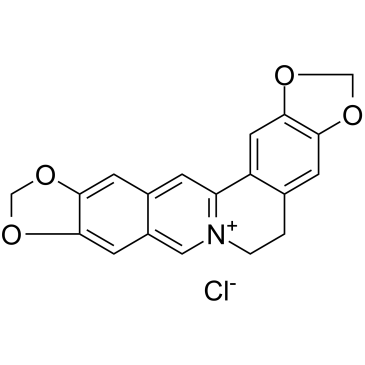Pseudocoptisine chloride
Modify Date: 2024-01-09 20:18:09

Pseudocoptisine chloride structure
|
Common Name | Pseudocoptisine chloride | ||
|---|---|---|---|---|
| CAS Number | 30044-78-1 | Molecular Weight | 355.77 | |
| Density | N/A | Boiling Point | N/A | |
| Molecular Formula | C19H14ClNO4 | Melting Point | N/A | |
| MSDS | N/A | Flash Point | N/A | |
Use of Pseudocoptisine chloridePseudocoptisine (Isocoptisine) chloride is a quaternary alkaloid with benzylisoquinoline skeleton, was isolated from Corydalis Tuber. Pseudocoptisine chloride inhibits acetylcholinesterase (AChE) activity with an IC50 of 12.8 μM. Anti-inflammatory and anti-amnestic effects[1][2]. |
| Name | Pseudocoptisine chloride |
|---|
| Description | Pseudocoptisine (Isocoptisine) chloride is a quaternary alkaloid with benzylisoquinoline skeleton, was isolated from Corydalis Tuber. Pseudocoptisine chloride inhibits acetylcholinesterase (AChE) activity with an IC50 of 12.8 μM. Anti-inflammatory and anti-amnestic effects[1][2]. |
|---|---|
| Related Catalog | |
| In Vitro | Pseudocoptisine (0, 60, 90 μM; 1 hour) dose-dependently inhibited LPS-induced NO production in RAW264.7 cells[2]. Pseudocoptisine (30-90 μM; 1 hour; RAW264.7 cells) significantly reduces the LPS-induced TNF-α and IL-6 production and their mRNA expressions[1]. Pseudocoptisine acetate reduces levels of the pro-inflammatory mediators, such as, iNOS, COX-2, TNF-alpha, and IL-6 through the inhibition of NF-kappaB activation via the suppression of ERK and p38 phosphorylation in RAW 264.7 cells[1]. |
| In Vivo | The anti-amnesic activities of Pseudocoptisine in mice on the learning and memory impairments induced by scopolamine (1.0 mg/kg, i.p.) are examined. Pseudocoptisine (2.0 mg/kg, p.o.) significantly reverses cognitive impairments in mice by passive avoidance test[1]. |
| References |
| Molecular Formula | C19H14ClNO4 |
|---|---|
| Molecular Weight | 355.77 |